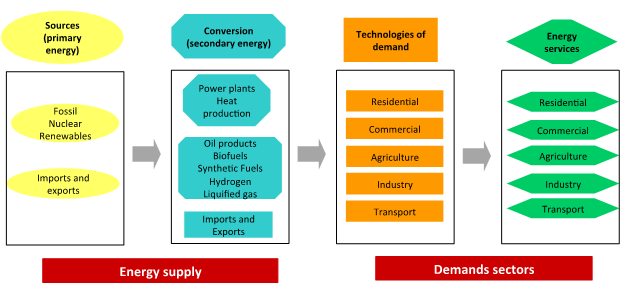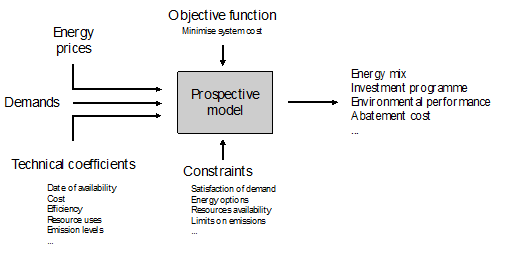- Analytical approach: Bottom-up
- Purpose: Scenario analysis
- Methodology: Optimization
- Deterministic and stochastic/robust versions
- Regions: Switzerland, Arc Lémanique region
- Sectors: Residential, Commercial, Agriculture, Transport, Industry, Electricity, etc.
- Static
- Time horizon: 2050
- Developer: Ordecsys
- Contact: Frédéric Babonneau
Energy-Technology-Environment-Model with Smart Grids (ETEM-SG)
ETEM-SG (Energy-Technology-Environment-Model with Smart Grids) is a “robust optimization” based capacity expansion model for an ensemble of energy related infrastructures that will be operated in a coordinated way in order to satisfy the demand for services in the urban community, with an optimal use of resources and reduced greenhouse gas (GHG) emissions. The model structure is inspired from MARKAL/TIMES (Fragnière and Haurie, 1996 and Loulou and Labriet, 2009). This long-term expansion model includes a model of electricity distribution, which reveals the future implicit prices on electricity markets under the conditions of massive penetration of renewables, grid storage and demand response (See Babonneau et al., 2015a and 2015b).

More precisely, ETEM is a linear programming model, which represents the optimal capacity expansion in production technology and the flow of resources in the whole energy system. In its standard version, the model is driven by exogenously defined useful energy demands (i.e., demand for energy services) and imported energy prices. All technologies are defined as resource transformers and are characterized by technical coefficients describing input and output, efficiency, capacity bounds, date of availability (for new technologies), life duration, etc. Economic parameters define investment, operation and maintenance costs for each technology. The planning horizon is generally long enough to offer a possibility for the energy system to have a complete investment technology mix turnover. Typically ETEM simulates the development of an efficient regional energy system with a planning horizon of 30 to 50 years usually divided in periods of 1 to 5 years; 3 seasons — Winter, Summer, Spring-Fall — and two week day types — working weekday, weekend-Holiday. Each of these days is subdivided into groups of hours, to obtain finally a set of time-slices that will be used to represent load curves and distribution of demand and resource availability in different seasons and at different time of the day.

ETEM-SG provides a simulation of the evolution of final energy demand and of environmental impact of energy production and use in smart cities, when one takes full advantage of the potential of load shedding, demand response and integration of renewables provided by smart energy systems. In this modeling approach one assumes market efficiency at all time scales, with price information reflecting the real marginal cost of the various technologies participating in the supply-demand equilibrium for each energy form. The model is multi-energy, with a particular attention devoted to electricity and power system. The model takes into account the ability of Distributed Energy Resources (DERs: broadly construed, distributed flexible loads, generation and other resources) to provide reserves, reactive power compensation and shift their operation over time so as to reduce losses, congestion, wholesale energy costs and distribution asset (particularly transformer) wear and tear.
Model inputs
- Complete description of the existing energy system
- Socio-economic drivers for the evaluation of future energy services demands
- Technology portfolio (Investment, operation and maintenance costs, efficiency, availability, lifetime, input/output, etc.)
- Imported energy prices
- Energy policies (Subsidies, renewables target, emissions objectives, etc.)
- Discount rate
- Technical parameters of distribution systems (voltage, resistance, reactance, level of system reserve requirement, reactive power share, etc.)
Model outputs
- Marginal energy prices
- Installed capacities for generation and demand technologies for all sectors
- Evolution of the electricity sector (supply and sectoral demand, load curves, fuel use, renewable penetration, etc.).
- Smart technology penetration (CHPs, electric cars, flexible loads, decentralized energy resources, storage units, etc.)
- CO2 emissions
References
- Andrey C., F. Babonneau and A. Haurie (2014). Time of Use (TOU) Pricing: Adaptive and TOU Pricing Schemes for Smart Technology Integration, Swiss Federal Office of Energy, Publication 291005,
- Andrey C., F. Babonneau, A. Haurie and M. Labriet (2015). Modélisation stochastique et robuste de l'atténuation et de l'adaptation dans un système énergétique régional. Application à la région Midi-Pyrénées, Natures Sciences Société, 23:133-149.
- Babonneau F., M. Caramanis and A. Haurie (2015a). Modeling Distribution Options and Constraints for Smart Power Systems with Massive Renewables Penetration, Technical report ORDECSYS.
- Babonneau F., M. Caramanis and A. Haurie (2015b). ETEM-SG: Optimizing Regional Smart Energy System with Power Distribution Constraints and Options, Technical report ORDECSYS.
- Babonneau F., A. Haurie, G. J. Tarel and J. Thénié (2012). Assessing the Future of Renewable and Smart Grid Technologies in Regional Energy Systems, Swiss Journal of Economics and Statistics, Vol. 148 (2), pp. 229-273.
- Fragnière E. and A. Haurie (1996). MARKAL-Geneva: A Model to Assess Energy- Environment Choices for a Swiss Canton, Chap. 3 in C. Carraro and A,. Haurie eds. Operations Research and Environmental Management, Fondazione Eni Enrico Mattei, Economics Energy Environment, Kluwer Academic Press.
- Loulou R. and Labriet M. (2009). ETSAP-TIAM, the TIMES integrated assessment model Part 1: Model structure. Computational Management Science, Vol. 5, pp.7- 40
